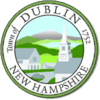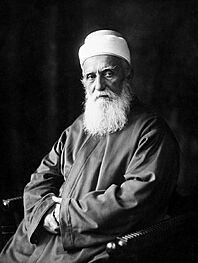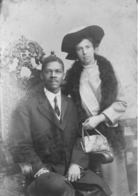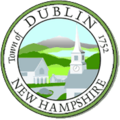Dublin, New Hampshire facts for kids
Quick facts for kids
Dublin, New Hampshire
|
||
|---|---|---|
|
Town
|
||
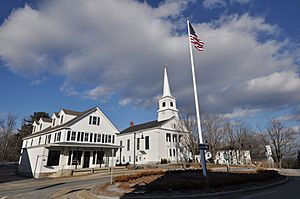
Church and rotary in the town center
|
||
|
||
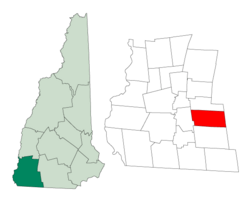
Location in Cheshire County, New Hampshire
|
||
| Country | United States | |
| State | New Hampshire | |
| County | Cheshire | |
| Incorporated | 1771 | |
| Villages |
|
|
| Area | ||
| • Total | 29.0 sq mi (75.1 km2) | |
| • Land | 27.9 sq mi (72.2 km2) | |
| • Water | 1.1 sq mi (2.8 km2) 3.78% | |
| Elevation | 1,440 ft (440 m) | |
| Population | ||
| • Total | 1,532 | |
| • Density | 52.83/sq mi (20.399/km2) | |
| Time zone | UTC-5 (Eastern) | |
| • Summer (DST) | UTC-4 (Eastern) | |
| ZIP code |
03444
|
|
| Area code(s) | 603 | |
| FIPS code | 33-19140 | |
| GNIS feature ID | 0873581 | |
Dublin is a small town located in Cheshire County, New Hampshire, in the United States. In 2020, about 1,532 people lived there. Dublin is known for being home to the Dublin School and the office of Yankee magazine.
Contents
History of Dublin
In 1749, a group of land owners called the Masonian proprietors gave the land for Dublin to Matthew Thornton and 39 other people. They called it "Monadnock No. 3." Most of these people were from other parts of New Hampshire and did not actually move to the new town.
It was hard for people to settle permanently in Dublin until the 1760s because of the French and Indian War. Then, an Irishman named Henry Strongman moved there from nearby Peterborough. Other early settlers came from Sherborn, Massachusetts. In 1771, Governor John Wentworth officially made Dublin a town. He named it after Strongman's hometown: Dublin, Ireland.
The land in Dublin has many hills and valleys. Early farmers found the soil tough and rocky. But with hard work, they could grow crops like corn, oats, barley, and potatoes. Some also grew wheat and rye. Fruit Orchards were also common. The first count of people in 1790 showed 901 residents. By 1859, the population grew to 1,088. However, in 1870, the small town of Harrisville decided to become its own town, separating from Dublin. This left Dublin with only 455 residents by 1880.
Geography and Nature
Dublin covers about 75.1 square kilometers (29 square miles). Most of this area, about 72.2 square kilometers (27.9 square miles), is land. The rest, about 2.8 square kilometers (1.1 square miles), is water.
The northern part of Mount Monadnock is in the southern part of Dublin. The highest point in Dublin is on Monadnock's northeastern ridge, reaching about 439 meters (1,440 feet) above sea level. Water in Dublin flows into two main river systems. The western half drains into the Connecticut River, while the eastern half drains into the Merrimack River.
Dublin has several beautiful ponds, including Monadnock Lake (now called Dublin Pond), Farnum (Dark) Pond, and Wight Pond. There are also Howe, Knight, and Electric Company reservoirs.
Dublin Pond is a very clear lake that has attracted many wealthy families to the area. It is surrounded by large forests that lead up to Mount Monadnock. From the pond's surface, you can see the mountain clearly. On a calm day, the mountain's reflection can be seen perfectly on the water.
Main roads that go through Dublin include New Hampshire Route 101 and New Hampshire Route 137. Route 101 goes east to Peterborough and west to Marlborough and Keene. Route 137 goes north to Hancock and south to Jaffrey.
Neighboring Towns
Dublin shares borders with these towns:
- Harrisville (to the north)
- Peterborough (to the east)
- Jaffrey (to the south)
- Marlborough (to the west)
Dublin's Climate
| Climate data for Dublin, New Hampshire | |||||||||||||
|---|---|---|---|---|---|---|---|---|---|---|---|---|---|
| Month | Jan | Feb | Mar | Apr | May | Jun | Jul | Aug | Sep | Oct | Nov | Dec | Year |
| Record high °F (°C) | 61 (16) |
61 (16) |
78 (26) |
84 (29) |
86 (30) |
95 (35) |
93 (34) |
90 (32) |
90 (32) |
77 (25) |
69 (21) |
62 (17) |
95 (35) |
| Mean daily maximum °F (°C) | 29 (−2) |
32 (0) |
41 (5) |
53 (12) |
66 (19) |
73 (23) |
78 (26) |
75 (24) |
67 (19) |
57 (14) |
45 (7) |
34 (1) |
54 (12) |
| Mean daily minimum °F (°C) | 8 (−13) |
10 (−12) |
20 (−7) |
30 (−1) |
41 (5) |
50 (10) |
55 (13) |
53 (12) |
45 (7) |
33 (1) |
26 (−3) |
15 (−9) |
32 (0) |
| Record low °F (°C) | −23 (−31) |
−21 (−29) |
−9 (−23) |
8 (−13) |
23 (−5) |
32 (0) |
41 (5) |
40 (4) |
24 (−4) |
13 (−11) |
4 (−16) |
−11 (−24) |
−23 (−31) |
| Average precipitation inches (mm) | 3.86 (98) |
3.04 (77) |
3.96 (101) |
3.91 (99) |
4.57 (116) |
4.05 (103) |
4.18 (106) |
4.30 (109) |
3.88 (99) |
4.03 (102) |
4.17 (106) |
3.90 (99) |
47.84 (1,215) |
| Average snowfall inches (cm) | 16.5 (42) |
19.6 (50) |
12.4 (31) |
5.3 (13) |
0.5 (1.3) |
0 (0) |
0 (0) |
0 (0) |
0 (0) |
0.4 (1.0) |
6.4 (16) |
16.4 (42) |
77.5 (197) |
Architecture in Dublin
Dublin's building history began with the early days of the United States. This was when the Federal style of architecture was popular. A local carpenter named Rufus Piper helped shape this style in Dublin. He was known for adding decorative fan-shaped windows to many houses, including his own and his grandfather's home.
Population Over Time
| Historical population | |||
|---|---|---|---|
| Census | Pop. | %± | |
| 1790 | 901 | — | |
| 1800 | 1,188 | 31.9% | |
| 1810 | 1,184 | −0.3% | |
| 1820 | 1,620 | 36.8% | |
| 1830 | 1,218 | −24.8% | |
| 1840 | 1,075 | −11.7% | |
| 1850 | 1,088 | 1.2% | |
| 1860 | 1,096 | 0.7% | |
| 1870 | 930 | −15.1% | |
| 1880 | 456 | −51.0% | |
| 1890 | 582 | 27.6% | |
| 1900 | 620 | 6.5% | |
| 1910 | 571 | −7.9% | |
| 1920 | 408 | −28.5% | |
| 1930 | 506 | 24.0% | |
| 1940 | 621 | 22.7% | |
| 1950 | 675 | 8.7% | |
| 1960 | 684 | 1.3% | |
| 1970 | 837 | 22.4% | |
| 1980 | 1,303 | 55.7% | |
| 1990 | 1,474 | 13.1% | |
| 2000 | 1,476 | 0.1% | |
| 2010 | 1,597 | 8.2% | |
| 2020 | 1,532 | −4.1% | |
| U.S. Decennial Census | |||
The population of Dublin has changed a lot over the years. In 1790, there were 901 people. The population grew to over 1,600 by 1820. However, after the town of Harrisville separated in 1870, Dublin's population dropped significantly to 456 in 1880. Since then, the number of residents has generally increased, reaching 1,532 people in 2020.
Local Economy
Dublin is home to Yankee Publishing Inc. This company publishes the famous Old Farmer's Almanac and Yankee magazine.
Schools in Dublin
Dublin has several schools:
- Dublin School: A private boarding school for both boys and girls, started in 1935.
- The Walden School: A summer music camp that takes place on the Dublin School campus.
- Dublin Christian Academy: A Christian school founded in 1963.
A Special Visit from ‘Abdu’l‑Bahá
In 1912, an important spiritual leader named ʻAbdu'l-Bahá visited Dublin. He was the son and chosen successor of Baháʼu'lláh, who founded the Baháʼí Faith. ‘Abdu’l‑Bahá spent 23 days in Dublin, from July 25 to August 16, as part of his trip across the United States. He had recently been released after 40 years of being held captive.
During his visit, he gave many talks about important ideas. These included treating everyone equally, the idea of the soul living forever, fairness in jobs and money, ending unfair treatment based on race, and the importance of both spiritual and regular education. He also spoke about how people from different parts of the world could come together.
While in Dublin, ‘Abdu’l‑Bahá stayed with Agnes Parsons, a Bahá’í socialite who had a summer home there. One of his most notable talks happened at the Parsons' boathouse on Dublin Pond. He spoke to local African-American workers about the need for friendship and unity between people of all backgrounds. At this gathering, he also announced the marriage of two young Bahá’ís: Louis Gregory, an African-American lawyer, and Louisa Mathew, a white English woman. He had suggested they marry each other earlier. At that time, marriages between people of different races were not allowed in many places, making this a very bold and important act.
‘Abdu’l‑Bahá was also asked to speak at the local Unitarian church, which is now called the Dublin Community Church. About 300 people came to hear him talk about spiritual education. The church still celebrates the anniversary of his visit and speech every year. A minister named Rev. Howard Colby Ives, who was there that day, later wrote about how special ‘Abdu’l‑Bahá's voice was, describing it as "like a resonant bell of finest timbre."
‘Abdu’l‑Bahá also spent time at the Dublin Inn. This building has since been bought and given to the Bahá’í community. It is now a place for gathering, prayer, and remembering history.
Community Events
The Dublin Gas Engine Meet on Cricket Hill Farm is a long-standing tradition in Dublin, going on for 48 years in 2019. It's the longest running event after the Town Meeting. Also, every year starting in October, the town gets ready for its Halloween events.
Famous People from Dublin
Many interesting people have connections to Dublin:
- ʻAbdu'l-Bahá (1844–1921): A spiritual leader who visited Dublin for 23 days.
- Galen Clark (1814–1910): A nature activist.
- Grenville Clark (1882–1967): A lawyer who was nominated for the Nobel Peace Prize.
- Doris Haddock (1910–2010): A political activist who walked 3,000 miles across the United States to support changes in how political campaigns are funded.
- Moses Mason, Jr. (1789–1866): A doctor and US congressman.
- William Preston Phelps (1848–1923): An artist known as "the Painter of the Monadnock."
- Abbott Handerson Thayer (1849–1921): An artist, naturalist, and teacher.
- Mark Twain (1835–1910): A famous writer, humorist, and lecturer who was a summer resident for two years.
Images for kids
See also
 In Spanish: Dublin (Nuevo Hampshire) para niños
In Spanish: Dublin (Nuevo Hampshire) para niños


